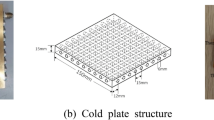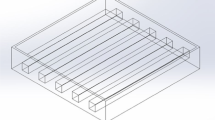Abstract
Naphthalene sublimation technique is employed to investigate three dimensional heat transfer characteristics of the simulated electronic chips. Experiments are performed for a single chip and chip arrays. In case of a single chip, local heat transfer coefficients on four surfaces of the chip are measured for various gap sizes and air velocities. Dramatic change of local heat transfer is seen on each surface of the chip, and gap size between chip and base plate is found to affect heat transfer significantly. In case of chip arrays, heat transfer characteristics from two-dimensional array of rectangular modules and three-dimensional array of hexahedral modules are investigated. Chip location, gap between chip and base plate and streamwise chip without gap. Fully developed behavior is found from the third row, but it slightly depends on flow conditions. Local and average heat transfer coefficients of three-dimensional modules are a little bit greater than those of two-dimensional modules. The differences in magnitude decrease as the longitudinal chip spacing decreases.
Similar content being viewed by others
Abbreviations
- B :
-
Height of simulated electronic chip
- D :
-
Mass diffusion coefficient of naphthalene vapor in the air
- H :
-
Height of the flow channel
- h :
-
Heat transfer coefficient
- h m :
-
Mass transfer coefficient
- L :
-
Width of the simulated electronic chip
- m :
-
Rate of mass transfer
- Nu :
-
Nusselt number
- Pr :
-
Prandtl number
- Re :
-
Reynolds number
- S :
-
Streamwise distance between chips
- Sc :
-
Schmidt number
- Sh :
-
Sherwood number
- Δt :
-
Sublimation depth of naphthalene
- Δτ:
-
Total exposure time in the wind tunnel
- ρs :
-
Density of the solid naphthalene
- ρv,ω :
-
Naphthalene vapor density on the surface
References
Ambrose, D., Lawrenson, I. J., and Sparke, C. H. S., 1975, “The Vapor Pressure of Naphthalene,”Journal of Chemical Thermodynamics, Vol. 7, pp. 1173–1176.
Cho, K., 1989, “Measurement of Diffusion Coefficient of Naphthalene into Air,”, Ph. D. Thesis, State University of New York.
Chyu, M. K., and Natarajan, V., 1991, “Local Heat/Mass Transfer Distributions on the Surface of a Wall-Mounted Cube,”ASME Journal of Heat Transfer, Vol. 113, pp. 851–857.
Goldstein, R. J., Yoo, S. Y. and Chung, M. K., 1990, “Convective Mass Transfer from a Square Cylinder and Its Base Plate,”International Journal of Heat and Mass Transfer, Vol. 33, pp. 9–18.
Perterson, G. P. and Ortega, A., 1990, “Thermal Control of Electronic Equipment and Devices,”Advances in Heat Transfer, Vol. 20, pp. 181–314.
Sparrow, E. M., Vemuri, S. B. and Kadle, D. S., 1983, “Enhanced and Local Heat Transfer, Pressure Drop and Flow Visualization for Arrays of Block-Like Electronic Components,”Int. J. of Heat and Mass Transfer, Vol. 26, pp. 689–699.
Yoo, S. Y., No, J. K., Chung, C. H. and Chung, M. K., 1993, “A Study on the Analogy between Heat Transfer and Mass Transfer,”Transaction of KSME, Vol. 17, pp. 2624–2633.
Author information
Authors and Affiliations
Rights and permissions
About this article
Cite this article
Yoo, S.Y., Park, J.H. & Kwark, Y.M. An experimental study on three dimensional heat transfer characteristics of simulated electronic chips. KSME Journal 10, 213–222 (1996). https://doi.org/10.1007/BF02953660
Received:
Issue Date:
DOI: https://doi.org/10.1007/BF02953660




